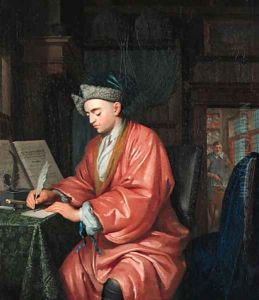Christoph Lubienietzki Paintings
Christoph Lubienietzki, born in 1659, was a notable figure in the world of art during the 17th and early 18th centuries. Although not as widely recognized today as some of his contemporaries, Lubienietzki made significant contributions to the Baroque movement, which was known for its exuberance, grandeur, and detail in exploring the depths of human emotion and the splendor of the natural world.
His early life was marked by a comprehensive education in the arts, under the tutelage of prominent artists of the time. This was a period when the art world was transitioning from the Mannerist style, which was characterized by artificiality and a penchant for elongation, to the Baroque, with its emphasis on clarity, movement, and sensory appeal. Lubienietzki's work clearly reflects this shift, as he embraced the Baroque's dynamism and emotional intensity.
Throughout his career, Lubienietzki was known for his masterful use of light and shadow, a technique that added a dramatic effect to his paintings. This was a hallmark of the Baroque style, aiming to evoke emotion and convey deeper meanings through visual storytelling. His subjects varied widely, including religious themes, which were quite popular at the time, as well as mythological scenes and portraits. These pieces often featured rich, vibrant colors and a remarkable attention to detail, which drew the viewer into the scene.
Lubienietzki's work was not only appreciated in his native region but also gained recognition abroad, which was an impressive feat at a time when travel and communication were limited. His ability to capture the essence of the Baroque spirit, combined with his technical skill, made his paintings highly sought after by patrons and collectors across Europe.
Despite his success, Christoph Lubienietzki's name has not endured in the public consciousness as strongly as some of his peers. This may be due in part to the sheer volume of talent during the Baroque period, which included giants such as Caravaggio, Rembrandt, and Rubens. However, among art historians and connoisseurs, Lubienietzki's work is still celebrated for its contribution to the evolution of European art.
Christoph Lubienietzki passed away in 1729, leaving behind a legacy that, while perhaps not as widely known as that of some of his contemporaries, remains an important part of the tapestry of Baroque art. His work continues to be studied and admired for its beauty, emotional depth, and technical mastery, securing his place in the annals of art history.
